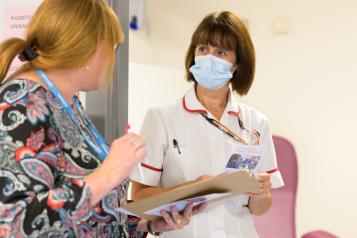The NHS can’t afford to be scared to talk about change

It is no secret that NHS and social care services face big challenges. How we respond is one of the key questions professionals will be discussing at Health and Care Expo - an annual event that I'm attending to talk about the need to involve the public as well in this debate.
More people are living longer, often with multiple long-term conditions, and the growing demand for support from services comes at a time when the cost of care is also increasing.
To help meet these challenges, health and social care services are going through reforms that aim to help make them more efficient and better at delivering tailored support.
Yet when professionals and policy makers sit down to talk about how things might be done differently there is often a strong sense of fear that whatever they propose they will face an army of activists campaigning to stop them.
Public engagement is nothing to fear
Healthwatch across the country know differently. Time and again our engagement with people shows they not only recognise the pressures on the NHS, but that they want to do their bit to help.
Projects like Healthwatch Dudley’s ACTIVATE programme, developed to support their local NHS Vanguard, show that allowing people to take a more active and open role in the decision making process generates very pragmatic, innovative and often quite radical ideas.
What’s more, such engagement shows that the suggestions of service users are not based in a world of limitless funding, rather they are quite realistic with a strong reference to the responsibilities we all have as patients to look after our own health.
What happens when communities aren’t involved
In contrast, making decisions without public engagement or involving them at the end of the process leaves communities with little understanding of the reasons for change, unclear as to how the proposals have been put together and with a feeling that any consultation exercise is largely meaningless.
Unsurprisingly, where the changes proposed are quite big, such as the closure of a local maternity ward or the downgrading of an A&E Department, people are left upset, feeling disenfranchised and determined to stand up for their NHS services.
This can be seen most recently in the way the new Sustainability and Transformation plans have been reported in the press.
Whilst we recognise that the development of the STPs is still in its very early stages, and that each area is due to step up its engagement activity, collectively the NHS needs to aim much higher to avoid causing such confusion and concern.
Healthwatch are here to help
Local Healthwatch, supported by more than 6,000 volunteers across England, are working hard helping to bring together decision makers together with their communities. And where engagement is inadequate they are not afraid to challenge.
Where things are working well, it is because local leaders are making the most of what Healthwatch already know about people’s views and experiences of health and social care services. Elsewhere in places like Norfolk and Waveney it is because the local Healthwatch is encouraging transparency right from the very start.
But Healthwatch can offer so much more. In Wiltshire and Cumbria, for example, we have already seen decision makers specifically commission their local Healthwatch to help, calling on their extensive community links and engagement expertise to reach out to their communities.
Across the whole country however, the involvement of the public in these big decisions is still too varied.
If the NHS and social care sector is to meet the challenge ahead it can no longer afford to fear public engagement. Early and open involvement of users is the only way to create a service that is both sustainable and delivers what people want and need.
How else is local Healthwatch making an impact?
Find out more about the work local Healthwatch do to help health and care services improve.


